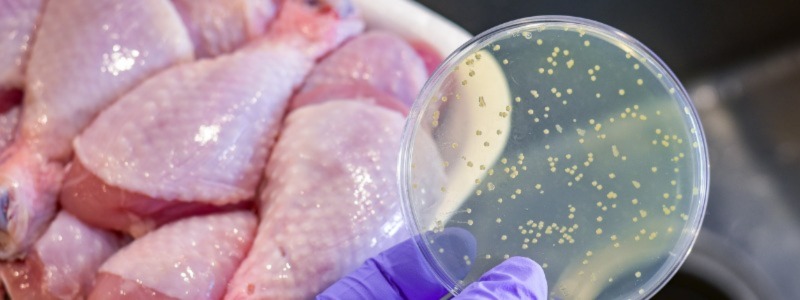How dangerous are the Salmonella on my food?
Posted on August 1, 2023 by Dr Samuel J. Bloomfield
Dr Samuel J. Bloomfield take us behind the scenes of their latest publication, 'Genomic diversity and epidemiological significance of non-typhoidal Salmonella found in retail food collected in Norfolk, UK’ published in Microbial Genomics.
My name is Dr Samuel Bloomfield, and I am a postdoctoral researcher in the group of Professor Alison Mather at the Quadram Institute, UK. My research focuses on understanding the role of different foods in disease and antimicrobial resistance using genomics and metagenomics.
Non-typhoidal Salmonella (NTS) are one of the largest causes of diarrhoea in Europe and one of the ways in which it can find its way to humans is through food. Our diets are constantly changing, as are international trading partners, altering the types of food we eat and where they originate from. We need to regularly test food for NTS to identify which foods are associated with this bacterium and contributing to infections.
We previously completed a year-long study collecting retail food from throughout the county of Norfolk in the UK, and isolated NTS from 9.6% of raw chicken, 3.7% of raw prawn and 1.3% of raw pork samples. However, we wanted to characterise the NTS further: what strains were present, how diverse were the NTS on each food sample and were they likely causing infections? To do this we used whole genome sequencing (WGS) to compare our food NTS isolates to those from human clinical isolates.
NTS are often organised into serovars based on the molecules on the surface of the bacterium. We found 14 NTS serovars on food and only one was isolated from multiple food commodities: Salmonella 1,4,[5],12:i:- from pork and chicken. We also isolated multiple serovars from two prawn samples. However, we wanted to delve into diversity past the serovar level, so we calculated the largest number of single nucleotide polymorphisms (SNPs) amongst isolates collected from the same serovar and sample. Most of the isolates belonging to the same serovar and sample were highly similar, differing by a median number of two SNPs, but we did identify one prawn sample that contained isolates that differed by 251 SNPs.
In England and Wales, 95% of NTS isolates from human clinical samples are sent to the United Kingdom Health Security Agency (UKHSA), which sequences the genomes of these isolates and uses the genomic data to identify emerging outbreaks. They often use five SNPs as a cut-off to identify NTS outbreaks. We found that 26% of NTS positive food samples contained isolates that differed by more than five SNPs. If we had only isolated a single isolate from these food samples, we would not have captured the diversity of NTS present and could have missed a linkage between the food source and clinical infections.
We compared the genomes of the NTS we had isolated from food to those from human clinical samples in the UK that are made available by the UKHSA and used their five SNP cut-off to identify food isolates closely related to human isolates. The food NTS isolates that were closely related to human isolates belonged to three serovars: Salmonella Infantis and Salmonella Enteritidis from chicken, and Salmonella 1,4,[5],12:i:- from pork and chicken. None of the NTS from prawns were closely related to human isolates, suggesting that prawns do not likely contribute to many NTS infections in the UK.
We had a large number of chicken samples (n=30) that were positive for NTS, so tried to find associations between the type of chicken sample and the presence of NTS closely related to human isolates. We found that 17% of imported chicken samples contained NTS that were closely related to human isolates compared to 2.3% of domestic chicken samples. However, most of the imported chicken samples were frozen unlike the domestic chicken samples that were mostly chilled. It was unclear whether the NTS from imported chicken were more dangerous, or this was due to consumers undertaking unsafe cooking practices with frozen chicken. Therefore, whole genome sequencing can identify associations between samples, but we still need traditional epidemiological studies to understand the sources of human infections.
Most NTS infections are self-limiting, but infections in immunocompromised patients may require antimicrobial treatment. NTS can acquire antimicrobial resistance (AMR) that makes treatment difficult. The NTS isolates we collected from food contained 0-7 AMR determinants. Multi-drug resistance (MDR) is where a bacterium is resistant to three classes of antimicrobial agents, and MDR NTS were isolated from both chicken and pork samples. However, none of the NTS isolates from prawns contained any known AMR determinants, suggesting that any NTS infections due to prawn consumption are likely to be treatable.
Our study on food NTS suggests that continued surveillance using whole genome sequencing could be used to identify putative sources of NTS infections and track AMR, but multiple isolates would need to be cultured to capture the diversity of NTS on food samples.

